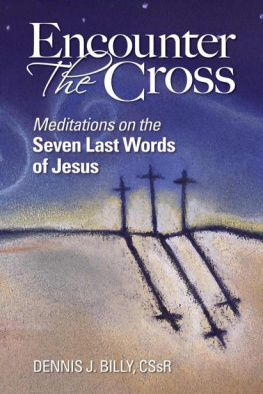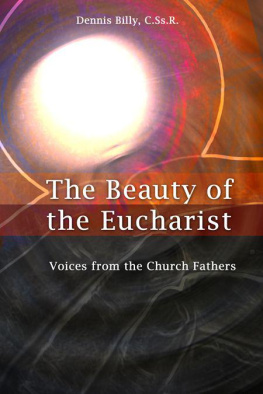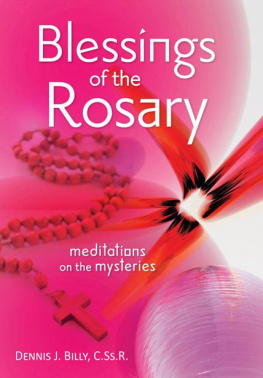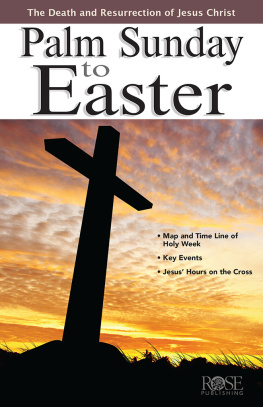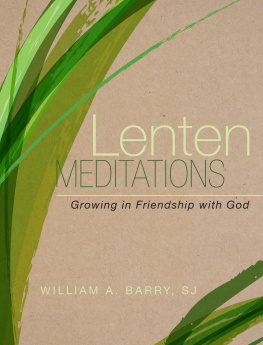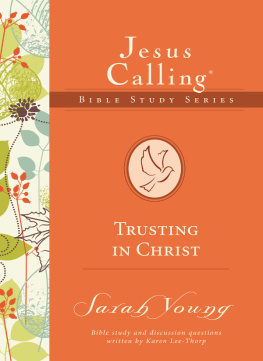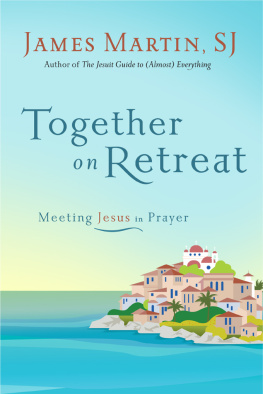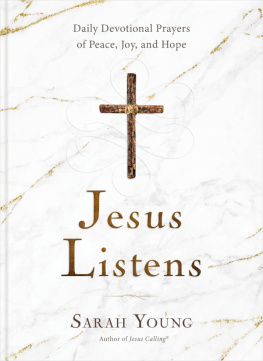Encounter
The Cross
Meditations on the
Seven Last Words
of Jesus
DENNIS J. BILLY, CSsR

Imprimi Potest: Thomas D. Picton, CSsR
Provincial, Denver Province, The Redemptorists
Published by Liguori Publications
1 Liguori Drive, Liguori, Missouri 63057
To order, call 800-325-9521 or visit www.liguori.org.
Copyright 2010 Dennis J. Billy
All rights reserved. No part of this publication may be reproduced, stored in a retrieval system, or transmitted in any form or by any means, except for brief quotations in printed reviews, without the prior written permission of Liguori Publications.
Library of Congress Cataloging-in-Publication Data
Billy, Dennis J.
Encounter the cross : meditations on the seven last words of Jesus / Dennis J. Billy.
p. cm.
ISBN 978-0-7648-1941-4 (alk. paper)
1. Jesus ChristSeven last wordsMeditations. I. Title.
BT457.B55 2010
232.9635dc22
2010022267
Scripture texts in this work are taken from the New American Bible with Revised New Testament and Revised Psalms 1991, 1986, 1970 Confraternity of Christian Doctrine, Washington, D.C., and are used by permission of the copyright owner. All Rights Reserved. No part of the New American Bible may be reproduced in any form without permission in writing from the copyright owner.
Excerpts from The cross is Christs glory and triumph, a discourse of St. Andrew of Crete (p. ix) and from The Lord Descends into Hell, an ancient homily (p. 103), quoted from English translation of The Liturgy of the Hours. Copyright 1970, 1973, 1975, International Committee on English in the Liturgy, Inc. All rights reserved.
Liguori Publications, a nonprofit corporation, is an apostolate of the Redemptorists. To learn more about the Redemptorists, visit Redemptorists.com.
Printed in the United States of America
14 13 12 11 10 5 4 3 2 1
First edition
In honor of
Jesus of Nazareth,
Son of Man,
Son of God

Jesus on the cross! Behold the proof of the love of God! Behold the final manifestation that he, the Word Incarnate, makes upon this eartha manifestation of suffering, indeed, but, still more, a manifestation of love!

SAINT ALPHONSUS LIGUORI
Contents

The Cross
Had there been no cross,
Christ could not have been crucified.
Had there been no cross,
life itself could not have been nailed to the tree.
And if life had not been nailed to it,
there would be no streams of immortality
pouring from Christs side,
blood and water for the worlds cleansing.
The legal bond of our sin would not be canceled,
we should not have obtained our freedom,
we should not have enjoyed the fruit of the tree of life
and the gates of paradise would not stand open.
Had there been no cross,
death would not have been trodden underfoot,
nor hell despoiled.

SAINT ANDREW OF CRETE
Introduction
A YOUNG WIFE AND MOTHER approaches death. She is about to succumb to the awful cancer that has been eating away at her for years. Sensing the end, she says in a low, gasping whisper to her entire family gathered around her deathbed, I love you all. With those words, she then slowly and gently fades into a coma from which she will never recover. Although she would speak to her family no more, they will remember her words of love for years to come. Through her final words to them, she speaks to her family every day.
Human societies have often found great solace in the final words of their loved ones. As a person nears his or her final hour and is about to cross the threshold of death, whatever is said is listened to with special reverence and is often considered by those around as a final testament about the meaning of life. By remembering their final words, those we love come closer to us. By pondering their last utterances, we are able to share in their life and death, and their spirits are somehow resurrected in our hearts.
This book presents and reflects upon the last words of Jesus of Nazareth as he hung from the cross. It is in keeping with the long-standing devotional practice of the Seven Last Words, which has deep roots in the traditional Catholic observance of Good Friday.
Jesus last utterances are garnered from the passion narratives of the Gospels of Luke (Luke 23:34, 43, 46), John (John 19:2627, 28, 30), and Matthew (Matthew 27:46).
Although there is no way of determining their actual chronological sequence, and even though the historical authenticity of some has been brought into question, the Catholic faithful have listened to these words for centuries and allowed them to penetrate their hearts.
In doing so, they have let the death of their Lord touch them in a very deep and personal way. By meditating on the dying words of the Word-made-flesh, believers of all times and places have been able to enter into his suffering and find meaning in their own.
Jesus final testament to them has given them the courage to face their own trials and impending death. It has also taught them that to be fully humanboth in life and in deaththey must personally encounter Jesus, the God of love, and allow him to dwell in their hearts and in their midst.
Jesus final utterances, however, can be fully understood only in the context of the details of his horrible death by crucifixion. This form of capital punishment is particularly brutal. It was widespread in ancient times and was practiced with special abandon by the Romans on the peoples they subjugated.
Condemned Roman citizens, by contrast, were dispatched through the swifter and less painful method of decapitation.
The purpose of crucifixion was twofold: first to punish the criminal by means of a slow, painful death, and second to set an example so that others would not transgress the law. The Romans made sure they taught these lessons.
Crucifixion by the Romans took place publicly and in the open air. It began with stripping the criminal and scourging him at the place of judgment. To shame him before the people, he was then forced to carry the cross-beam of the cross naked through the streets to the place of execution.
Along the way, he was mocked and often spat upon by those who lined the streets. If his strength appeared to wane, someone was forced to carry the cross-beam for him so that he would not die before he reached the place of execution.
Once there, the naked criminal was fastened to the cross-beam by rope or by nail. He was then hoisted high in the air so the cross-beam could rest either at the top of the vertical beam, which was either permanently in place or in a specially carved notch near the top.
Above his head was placed an inscription listing the crime for which he was being executed. To augment his torments, the criminals feet were usually fastened or nailed to a wooden support so he would be able to breathe by pulling up with his arms and pushing down with his legs. If the legs were left dangling in the air, death would come much sooner.
Next page
